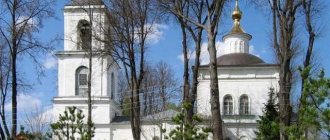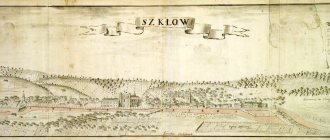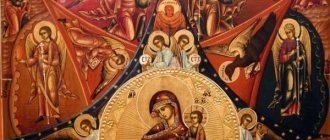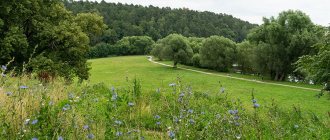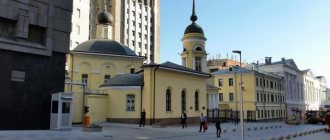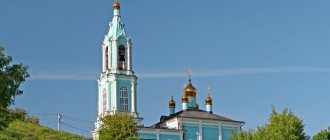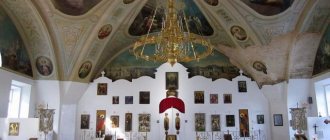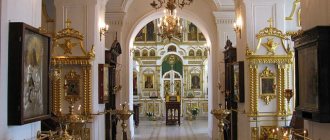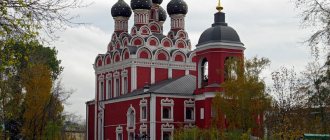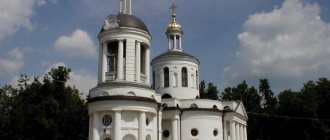Mir
Russia Moscow region Bykovo village Church of the Vladimir Icon of the Mother of God (Bykovo) Map is loading…
{"format":"leaflet","minzoom":false,"maxzoom":false,"limit":50,"offset":0,"link":"all","sort":[""], "order":[],"headers":"show","mainlabel":"","intro":"","outro":"","searchlabel":"\u2026 \u0441\u043b\u0435\ u0434\u0443\u044e\u0449\u0438\u0435 \u0440\u0435\u0437\u0443\u043b\u044c\u0442\u0430\u0442\u044b","default":"","import-annotation":false,"width ":"auto","height":"350px","centre":{"text":"","title":"""link":"""lat":55.610083000000003039531293325126171112060546875,"lon": 38.05808300000000343743522535078227519989013671875,"icon":""},"title":"","label":"","icon":"","lines":[],"polygons":[],"circles":[ ],"rectangles":[],"copycoords":false,"static":false,"zoom":8,"defzoom":14,"layers":["OpenStreetMap"],"image layers":[] ,"overlays":[],"resizable":false,"fullscreen":true,"scrollwheelzoom":true,"cluster":false,"clustermaxzoom":9,"clusterzoomonclick":true,"clustermaxradius":80, "clusterspiderfy":true,"geojson":"","clicktarget":"","showtitle":true,"hidenamespace":false,"template":"","userparam":"","activeicon": "","pagelabel":false,"ajaxcoordproperty":"","ajaxquery":"","locations":[{"text":"\u003Cb\u003E\u003Ca href=\"/palomnik/%D0% A6%D0%B5%D1%80%D0%BA%D0%BE%D0%B2%D1%8C_%D0%92%D0%BB%D0%B0%D0%B4%D0%B8%D0%BC% D0%B8%D1%80%D1%81%D0%BA%D0%BE%D0%B9_%D0%B8%D0%BA%D0%BE%D0%BD%D1%8B_%D0%91%D0% BE%D0%B6%D0%B8%D0%B5%D0%B9_%D0%9C%D0%B0%D1%82%D0%B5%D1%80%D0%B8_(%D0%91%D1%8B %D0%BA%D0%BE%D0%B2%D0%BE)\» title=\»\u0426\u0435\u0440\u043a\u043e\u0432\u044c \u0412\u043b\u0430\u0434\u0438\u043c\ u0438\u0440\u0441\u043a\u043e\u0439 \u0438\u043a\u043e\u043d\u044b \u0411\u043e\u0436\u0438\u0435\u0439 \u041c\u0430\u0442\u 0435\u0440\u0438 (\u0411\u044b \u043a\u043e\u0432\u043e)\»\u003E\u0426\u0435\u0440\u043a\u043e\u0432\u044c \u0412\u043b\u0430\u0434\u0438\u043c\u0438\u044 0\u0441\u043a\u043e\ u0439 \u0438\u043a\u043e\u043d\u044b \u0411\u043e\u0436\u0438\u0435\u0439 \u041c\u0430\u0442\u0435\u0440\u0438 (\u0411\u044b\ u043a\u043e\u0432\u043e)\ u003C/a\u003E\u003C/b\u003E\u003Chr /\u003E\u003Ca href=\»/palomnik/%D0%A1%D0%B2%D0%BE%D0%B9%D1%81%D1%82% D0%B2%D0%BE:%D0%90%D0%BD%D0%BD%D0%BE%D1%82%D0%B0%D1%86%D0%B8%D1%8F\» title=\» \u0421\u0432\u043e\u0439\u0441\u0442\u0432\u043e:\u0410\u043d\u043d\u043e\u0442\u0430\u0446\u0438\u044f\»\u003E\u0410\u043d \u043d\u043e\u0442\ u0430\u0446\u0438\u044f\u003C/a\u003E: »'\u0426\u0435\u0440\u043a\u043e\u0432\u044c \u0412\u043b\u0430\u0434\u0438\u043c\u04 38\u0440\u0441\u043a \u043e\u0439 \u0438\u043a\u043e\u043d\u044b \u0411\u043e\u0436\u0438\u0435\u0439 \u041c\u0430\u0442\u0435\u0440\u0438"' \u2 014\u0437\u043d\u0430\u043c \u0435\u043d\u0438\u0442\u044b\u0439 \u043f\u0430\u043c\u044f\u0442\u043d\u0438\u043a \u0440\u0443\u0441\u0441\u043a\u043e\ u0439\u043f\u0441\u0435\u0432 XVIII \u0432\u0435\u043a\u0430 \u0432 \u0441\u0435\u043b\u0435 \u0411\u044b\u0 43a\u043e\u0432\u043e\u0420\ u0430\u043c\u0435\u043d\u0441\u043a\u043e\u0433\u043e\u0440\u0430\u0439\u043e\u043d\u0430 \u041c\u043e\u0441\u043a\u043e\u0 432\u0441\u043a\u043e\u0439\ u043e\u0431\u043b\u0430\u0441\u0442\u0438. \u0412\u0435\u0440\u0445\u043d\u044f\u044f \u0446\u0435\u0440\u043a\u043e\u0432\u044c \u043e\u0441\u0432\u044f\u0449\u0435\ u043d\u0430\u043a\u0430\u043a \u0412\u043b\u0430\u0434\u0438\u043c\u0438\u0440\u0441\u043a\u043e\u0439 \u0438\u043a\u043e\u043d\u044b \u0411\u043e\u0436\ u0438\u0435\u0439\u041c\u0430 \u0442\u0435\u0440\u0438 \u0445\u0440\u0430\u043c \u0432 \u043f\u043e\u0434\u043a\u043b\u0435\u0442\u0435 \u2014 \u0425\u04 40\u0438\u0441\u0442\u043e\u0440 """title":"\u0426\u0435\u0440\u043a\u043e\u0432\u 044c\u0412 \u043b\u0430\u0434\u0438\u043c\u0438\u0440\u0441\u043a\u043e\u0439 \u0438\u043a\u043e\u043d\u044b \u0411\u043e\u0436\u0438\ u0435\u0439\u041c\u0430\u0442 \u0435\u0440\u0438 (\u0411\u044b\u043a\u043e\u0432\u043e)","link":"","lat":55.610083000000003039531293325126171112060546875,"lon":38. 05808300000000343743522535078227519989013671875,"icon":""}], "imageLayers":[]}
55.611612; 38.052851
Russia, Moscow region, Ramensky urban district, Bykovo village
Bykovo village, Moscow region
Russia
Telephone:
(49646) 2-41-26.
Church of the Vladimir Icon of the Mother of God
- a famous monument of Russian pseudo-Gothic of the 18th century in the village of Bykovo, Ramensky district, Moscow region. The upper church is consecrated as the Vladimir Icon of the Mother of God, the temple in the basement is the Nativity of Christ.
History[edit]
2 km from the station. Bykovo there is an old estate that belonged to the 18th century. to the famous Catherine nobleman, the marshal and head of the Kremlin “building expedition” M. M. Izmailov, who attracted the outstanding architects of that time, V. I. Bazhenov and M. F. Kazakov, to the construction. A manor house surrounded by a large park, a rotunda gazebo and a church have been preserved here. Now there is a sanatorium in the estate.
In Bykov, from time immemorial, there was a wooden church in honor of the Nativity of Christ, which was first mentioned in 1628. With funds from the palace order, a stone Nativity church with a bell tower was erected here in 1704. In 1780, the owner of the village, M. M. Izmailov, having become a widower, decided to build a large temple with a chapel in the name of St. Petersburg in memory of his deceased wife. Mary of Egypt. During construction, a small church-chapel was built and consecrated in 1783 in honor of the Nativity of Christ.
The temple in honor of the Vladimir Icon of the Mother of God was built on the second floor in 1788. The church was built according to the design of V. I. Bazhenov (according to another version - M. F. Kazakov or A. N. Bokarev) in the romantic style of Russian architecture of the late 18th century. The church is two-story, with two bell towers, and has an oval shape in plan (the only temple in Russian architecture). Two white stone staircases lead to the second floor of the temple on the western side. The facades of the temple are richly decorated with carved architectural details. The interior of the church is made in the style of Russian classicism, with elegant fine molding and wood carvings. Beautiful paired bell towers located on the sides of the staircase form a picture of rare originality and integrity. Paired two-column porticoes topped with pointed pyramids decorate the side facades of the building. One bell tower was intended for ringing, the other for a clock.
In 1937, the church was closed and destroyed: crosses were knocked off the domes, bells were thrown off, and many valuable utensils, icons and books were burned. In an outstanding architectural monument of the 18th century. a garment factory was located, and later a warehouse for the film production department. In 1937, all the clergy of the Vladimir Church were shot: John of Caesarea, Pyotr Kosmenkov, Semyon Krechkov. Now they are numbered among the Council of New Martyrs and Confessors of Russia.
The temple opened for worship in 1989. Restoration work is underway.
Inner space
The plan of the cathedral consists of equal semicircles on the western and eastern sides, they are connected by straight walls. The basis for the artistic and constructive concept of the building and the organization of the interior were the principles of the ancient Russian construction of tetrameter churches.
In addition, the architect used classic order style here, giving the interior decoration an expressive lightness.
- In the lower tier, consecrated in honor of the Nativity of Christ, there was a three-tiered iconostasis with images of the Holy Spirit, the Virgin Mary, Gabriel and the evangelists. Nearby hung icons framed in gold and silver.
- The altar of the upper tier of the church, consecrated in honor of the Vladimir image of the Virgin Mary, is decorated with an oval colonnade. The elegant effect of the interior is created by pink marble and black veins on it.
- To the left of the royal gates was kept the ancient Kazan icon of the Most Pure Virgin, to the right - the image of Christ. The Vladimir painting appeared in the pre-altar room in the 19th century. The luxurious decoration of the upper church was a gilded copper chandelier, reminiscent of an 18th-century chandelier.
Interior of the Church of the Vladimir Icon of the Mother of God
- Precious images of various sizes were kept in icon cases and on the walls. Icons were divided into two types: the first included those created in an artistic manner, the second - those made on the basis of traditional writing.
- In 1914, the walls of the lower church were painted with oil paints by masters of various qualifications. In the upper tier there appeared figures of cherubs on a green background. In 1985, work was carried out to clean all interior paintings. The discovered images turned out to be extremely damaged.
On a note! Parishioners of the Vladimir Cathedral have always been in awe of the external appearance of the building. If you look at it from a distance, you can compare the structure with a medieval castle or a fantastic ship. The unique church brings together parishioners seeking the Word of God here.
How to get there[edit]
Address:
Moscow region, Ramensky district, village. Bykovo, st. Kolkhoznaya.
Telephone:
(49646) 2-41-26.
Travel by public transport:
from the Kazansky railway station to the Udelnaya station, then buses No. 23, 39 to the Khram (Club) stop.
Next, walk along the narrow passage between the fences, along which you need to exit onto a parallel street, then turn right, walk a little and turn left. The total walk is about 400 m.
How to get to the Vladimir Church by car:
from Moscow along the Ryazanskoe highway to the turn to Bykovo (via Zhilino) - 8 km, then turn left. Next - travel not to the airport, but to the towns of Bykovo and Zhukovsky. Drive right through Bykovo, at the border between Bykovo and Zhukovsky at the traffic lights turn right, then after 200 m turn right again onto the street. Highway, and drive along it to the Vladimir Church.
Myths and legends
Numerous legends surround the image of the Virgin Mary about her help during battles with foreign invaders.
They say that during the reign of Yuri Dolgorukov, the mother of Jesus Christ appeared to him. She ordered the icon to be taken to the city of Vladimir and a church built for it. So the icon received the title of Vladimir.
The chronicles also claim that thanks to this holy image, not a single country has so far managed to conquer Holy Rus'. The great Asian commander Tamerlane gave the order to retreat from Russian borders after the appearance of the Mother of God to him.
In honor of this event and 2 other miracles of liberation from the invaders, church holidays are celebrated.
Closing of the temple and its restoration
In 1930 the cathedral was closed. The building was transferred to the State Public Libraries and other book depositories. The purpose of all activities was to locate a branch of the Anti-Religious Library, and then a construction trust.
The temple withstood the blockade, but at the end of the war it was again transferred to the book collections of the Library of the Academy of Sciences. And in 1947, the Lenin industrial plant and physical culture industrial supply for textile sewing.
And only in 1989, by decision of the Leningrad City Council, the temple was again given to Christians, namely to the Leningrad Diocese. High-ranking St. Petersburg residents helped in the repatriation of the cathedral. Of them: L. N. Gumilyov - a famous writer, historian and patriot, D. S. Likhachev - Honorary Citizen of St. Petersburg.
On April 7, 1990, the temple was consecrated by Metropolitan Alexy of Leningrad and Novgorod, who became its rector. The candidate of theology, Vladimir Fomenko, archpriest, was recognized as the keymaster of the cathedral.
From 1996 to this day, His Eminence Vladyka Vladimir, Metropolitan of Ladoga and St. Petersburg, remains the rector of the temple. Ivan Sergeevich Raevsky was recognized as the chairman of the parish council.
Divine service in Vladimir Cathedral
Today, restoration work is underway in the temple to restore iconostasis, decorations and decorated art. Of these, the following have already been restored: 8 gilded crosses, the upper temple, the domes of the temple, bell towers, the facade and the interior of the entire cathedral has been refreshed.
History of the Cathedral
The history of the majestic temple began in the 18th century with a small temporary church located in a private house, which was visited by townspeople living in the area. There was not enough space for parishioners, and then in 1745 a small wooden church , the basis for which was the old chapel.
This church quickly fell into disrepair, and city residents turned to the empress with a request to build a new building
In 1760, the stone foundation was laid for a grandiose construction project. The fundraiser was organized by John Kirikov , who did not live to see the consecration of the temple for 13 years; he died at the hands of robbers. The exact opening date is unknown; the temple was consecrated in 1783 .
The reconstruction of the church was accompanied by the redevelopment of the surrounding territory, so of the same name appeared - Vladimirskaya.
History of the image
The temple is named after the Miracle-Working Icon of the Mother of God ; according to legend, it was painted by Luke on the tabletop, at which the Savior and the Mother of God had previously eaten.
Seeing the image created by the Holy Apostle, the Most Pure Virgin said: “The grace of the One born of Me and Mine be with this image.”
In the 12th century, was made and presented to the Principality of Kiev to Yuri Dolgoruky , the original was in Constantinople.
The Holy Image was placed in the Kiev monastery, but a few years later one of Dolgoruky’s sons , Andrei, decided to transport the icon to the north of the state. During the move, after a rest in the city of Vladimir , the horses carrying the platform on which the icon was located stopped and did not want to move further.
The prince turned to the Savior in prayer for help. In a vision, the Mother of God appeared to him and commanded him to leave the icon in this city, since then it has been named Vladimir.
Moving icons:
- in 1480, the Face of the Savior was transported to the Moscow Patriarchate and placed in the Assumption Cathedral ; a copy created by Andrei Rublev remains in Vladimir
- after the revolution, the image was placed in the Tretyakov Gallery , where it remained until the end of the twentieth century
- in 1999 she was transported to Tolmachi, to the Church of St. Nicholas
Since the appearance of the Miraculous Image, many amazing events associated with it have been recorded.
- At the end of the 14th century, a religious procession was held with the Great Image in hand. People asked the Mother of God to protect them from Khan Tamerlane , who attacked Russia. The Savior appeared to Tamerlane in a dream and ordered him to stop the war . Khan obeyed and retreated.
- A procession along the city walls with the Miraculous Icon in their hands saved the capital from an attack by the Tatars in the middle of the 15th century. After a crowded prayer of the townspeople to the Mother of God, for unknown reasons, the Tatars stopped the siege of the city.
- The battle with the Tatar-Mongols never took place at the end of the 15th century. Russian soldiers came out to meet the enemy, carrying the icon of the Savior in the front row. The enemy immediately retreated .
Many miracles and healings are associated with the Miraculous Icon. Prayers to her are always heard; they have more than once saved the country and everyone who turned to her with faith and hope during difficult trials. As a sign of gratitude, people brought pearls, gold and silver rings, which they used to decorate the Image of the Savior.
In the Cathedral there is a copy of the Miraculous Icon, revered no less than the original, which is placed in a case with bulletproof protection and is located in the Tretyakov Gallery Museum.
Temple status
The cathedral , in which the Miraculous Image is located, is considered the most important and significant in its region. cathedral status in 2000. It is given forever and is not subject to revision, therefore the cathedral occupies a special position - it is distinguished from a simple temple by the fact that Divine Services are conducted only by the Highest Spiritual Priests :
- bishop
- archbishop
- patriarch
- metropolitan
The category of Cathedral is assigned for some special reason; Divine Liturgies are conducted in them by the bishop. In such a Cathedral, the presence of a pulpit is required - a special episcopal throne, which is installed on the eastern side of the altar.
The architecture of the church and its interior decoration
The three-apsid one-story church was built in the best traditions of classicism. It is a brick, stucco building, painted blue and white. The entrance to it is decorated with an elegant porch. A small gilded dome rises above a faceted blue semi-dome, on which large golden stars sparkle.
The interior spaces are decorated with wall paintings made in the 2000s by masters of Optina Pustyn. The area around the temple is landscaped. Near the church building there are flower beds, and slender spruce and cypress trees grow.
View of the cathedral dome
Shrines and patronal feasts
The church houses sacred images of Our Lady of Vladimir and Kazan, icons of the Nativity of Christ and St. Nicholas the Wonderworker, as well as paintings depicting the healer Panteleimon. Patronal feasts are celebrated here on September 8, June 3 and July 6.
The parish celebrates all religious holidays, and there is a Sunday school here. The community organizes charity meetings with children and youth. The clergy faithfully perform their duties on holidays, but do not forget to lift the spirits of parishioners on weekdays.
